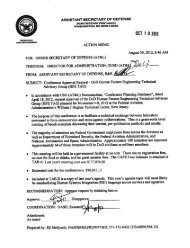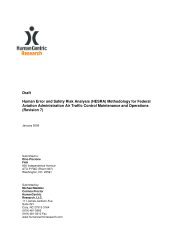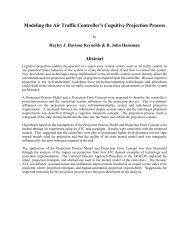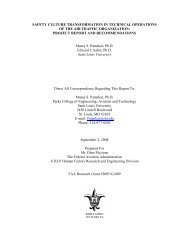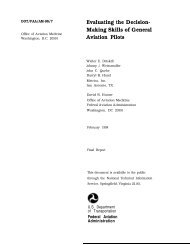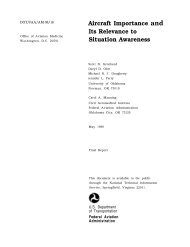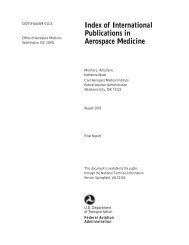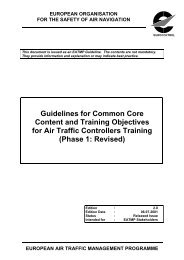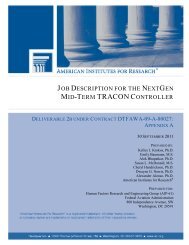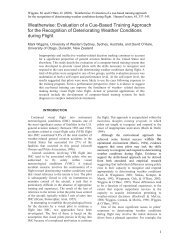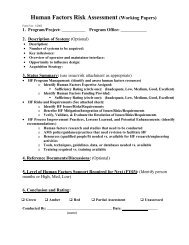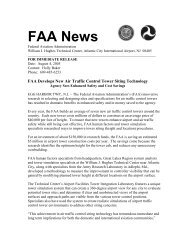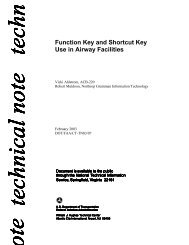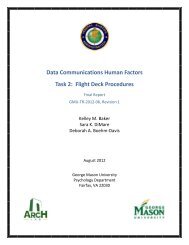job description for the nextgen mid-term atct controller - FAA Human ...
job description for the nextgen mid-term atct controller - FAA Human ...
job description for the nextgen mid-term atct controller - FAA Human ...
You also want an ePaper? Increase the reach of your titles
YUMPU automatically turns print PDFs into web optimized ePapers that Google loves.
DRIVER 4: DATA COMMUNICATIONS<br />
Data Communications (Data Comm) refers to a digital communication system that will provide<br />
<strong>controller</strong>s with <strong>the</strong> capability to communicate with pilots using a computer-based data entry<br />
system—assuming that aircraft are properly equipped and <strong>the</strong> message meets certain operational<br />
constraints. Data Comm is a large system comprising multiple ground and airborne subsystems<br />
that interact with each o<strong>the</strong>r to exchange messages between <strong>controller</strong>s and pilots.<br />
Data Comm will result in a number of benefits. First, Data Comm will reduce <strong>the</strong> number of<br />
radio transmissions, which will reduce <strong>the</strong> congestion on radio frequencies that is so prevalent<br />
near high-density airports. Evidence that this benefit will be realized is supported by human-in<strong>the</strong>-loop<br />
(HITL) experiments conducted at <strong>the</strong> William J. Hughes Technical Center, which<br />
showed that dissemination of taxi-out instructions via Data Comm reduced voice frequency use<br />
on <strong>the</strong> ground control frequency by 12% when 75% of <strong>the</strong> departure aircraft were equipped with<br />
Data Comm. Second, Data Comm will allow <strong>controller</strong>s to work more efficiently. For example,<br />
<strong>controller</strong>s will be able to send a single message to multiple aircraft simultaneously if <strong>the</strong> aircraft<br />
are properly equipped. Data Comm can be used to transmit longer, more complex messages than<br />
could be adequately communicated in a voice communication. Third, Data Comm will reduce<br />
hearback/readback errors. Finally, Data Comm supports shared situation awareness. That is,<br />
Data Comm messages are typed into <strong>the</strong> system, which will allow control instructions to be<br />
reflected in air traffic management systems.<br />
Latency challenges are associated with Data Comm messaging, and <strong>the</strong> length of <strong>the</strong> latency is<br />
variable. Although <strong>the</strong> exact delay in Data Comm messages is unknown, <strong>for</strong> Data Comm to<br />
meet requirements to be implemented in Segment One, it must meet a 95th percentile latency<br />
requirement of 8 seconds or less <strong>for</strong> time-critical clearance messages and of 30 seconds or less<br />
<strong>for</strong> all o<strong>the</strong>r data messages. In addition, delays will likely be associated with <strong>controller</strong>s and<br />
pilots recognizing <strong>the</strong> receipt of Data Comm messages and crafting and sending a response. Due<br />
to <strong>the</strong>se latency challenges, it is anticipated that radio transmissions will continue to be used <strong>for</strong><br />
time-sensitive messages and that Data Comm messaging will be reserved <strong>for</strong> issues that are less<br />
time sensitive. Despite this challenge, which will persist into 2018, <strong>the</strong> benefits of data<br />
communications are significant.<br />
Data Comm is proposed to be implemented in three phases: Segment One, 2012 through 2017;<br />
Segment Two, 2017 through 2022; and Segment Three, 2022 and beyond. Consequently, <strong>the</strong><br />
ATCT line <strong>controller</strong>s’ <strong>job</strong> in <strong>the</strong> <strong>mid</strong>-<strong>term</strong> will be affected primarily by Segment One and<br />
marginally by Segment Two. These two segments are presented in detail below:<br />
• Segment One (2012–2017): Segment One functionalities will enable ATCT line<br />
<strong>controller</strong>s to meet many of <strong>the</strong>ir data communications requirements. For example, in<br />
Segment One, Data Comm will allow <strong>controller</strong>s to compose messages, will provide<br />
predefined messages <strong>for</strong> <strong>controller</strong>s, and will allow <strong>the</strong>se messages to be transmitted. In<br />
this segment, <strong>the</strong> <strong>FAA</strong> will add <strong>the</strong> ability to broadcast messages in mass <strong>for</strong>mat.<br />
Fur<strong>the</strong>r, in <strong>term</strong>s of ATCT-specific requirements, Data Comm will be used <strong>for</strong><br />
transmitting Automated Terminal In<strong>for</strong>mation Service (ATIS) messages and o<strong>the</strong>r<br />
functions. For example, Data Comm will process requests <strong>for</strong> current ATIS and enable<br />
NAS users to manage <strong>the</strong> contents of <strong>the</strong> ATIS.<br />
38



